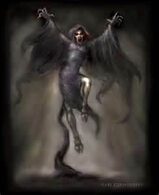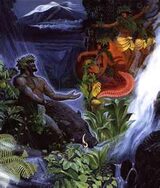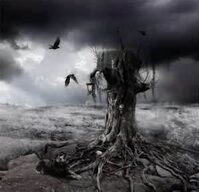Cryptozoology is the study of animals and other creatures that have not yet been accepted by science as real. In other words, it is monster-hunting. Cryptozoologists look for creatures like sea serpents and the yeti, hoping to gather enough evidence to prove that these beings exist. They also look for more commonplace animals, such as the ivory-billed woodpecker, the giant vampire bat, the inflatable hedgehog and the pygmy elephant. Creatures that are under investigation by cryptozoologists are called cryptids. Although cryptozoology doesn't get much respect from other scientific disiplines, it has had some spectacular success stories, including the pongo (now known as the gorilla), the okapi (an animal that looks like a cross between a giraffe and zebra), and the coelacanth (a prehistoric fish thought to be extinct).
Cryptozoologists are a specialized branch of monster hunters. Since their ultimate goal is to discover either new species of animal or new subspecies, the science of cryptozoology is rooted in biology. The more a creature shows evidence of being supernatural, the less likely it is that cryptozoologists would be interested in it. Not many cryptozoologists investigate the strangest things like ghostly demon cats, Mothman or werewolves. Ghost hunts are left to the paranormal investigators and a few fringe cryptozoologists. On the other hand, there are very few animals, however mythical they may be, that have never stirred the interest of a cryptozoologist. This is because perfectly real animals have often been obscured by so much folklore that they seemed ridiculous.
Bernard Heuvelmans, the author of the first and most influential book of cryptozoology, On the Track of Unknown Animals, created cryptozoology as a science and separated it from other studies involving anomalies and the paranormal. Earlier writers in the field were more likely to include mythology and folkloric material, and they used the terms "exotic zoology" and "romantic zoology" to describe what they did. Today there are many organizations devoted to cryptozoology, and dozens of books, plus countless individual scientists. Despite this massive amount of interest, most cryptozoologists are underfunded and sink large amounts of their own money into their researches.
Most of the time, cryptozoologists do not work in the field. The creatures they pursue are so rare and elusive that, even if they do exist, any particular expedition is unlikely to encounter one. It is much easier to collect sightings from witnesses who came across the cryptid by accident. Since most cryptids have remained in the realm of the mythical, the main job of cryptozoologists is not to prove that a certain cryptid exists, but rather to collect and analyze as many sightings as possible in order to determine if the available evidence is strong enough to keep the question open.
If they can make a good case for keeping the question open, they may be able to attract zoologists to the problem, which in turn brings the kind of research funding and manpower that has a real chance of uncovering an undiscovered animal. Alas, as soon as an animal becomes truly respectable, it exits the field of cryptozoology. The real science begins when a cryptid is being more seriously investigated by biologists than by cryptozoologists. Because cryptozoology is by definition a speculative science, cryptozoologists often rub shoulders with folklorists, Forteans, paranormal investigators and creationists, whether they want to or not.
This zoo is roughly divided into three sections. Most cryptozoological beings can be classified as humanoids (something like a human), draconic (it reminds you of a dragon) and animals (everything else). Inside these broad classifications you will find many individual creatures. Each creature has a description that defines what it is and where it is seen, plus a list of resources such as books, websites and documentary films that mention the creature. Most of these resources are firmly rooted in cryptozoology, but some of them approach these creatures from a different viewpoint such as that of folklore and mythology.
Throughout the early modern period, the English term "witch" was not exclusively negative in meaning, and could also indicate cunning folk. "There were a number of interchangeable terms for these practitioners, 'white', 'good', or 'unbinding' witches, blessers, wizards, sorcerers, however 'cunning-man' and 'wise-man' were the most frequent." The contemporary Reginald Scott noted, "At this day it is indifferent to say in the English tongue, 'she is a witch' or 'she is a wise woman'".Folk magicians throughout Europe were often viewed ambivalently by communities, and were considered as capable of harming as of healing, which could lead to their being accused as "witches" in the negative sense. Many English "witches" convicted of consorting with demons seem to have been cunning folk whose fairy familiars had been demonised; many French devins-guerisseurs ("diviner-healers") were accused of witchcraft, and over one half the accused witches in Hungary seem to have been healers.
Some of the healers and diviners historically accused of witchcraft have considered themselves mediators between the mundane and spiritual worlds, roughly equivalent to shamans. Such people described their contacts with fairies, spirits often involving out-of-body experiences and travelling through the realms of an "other-world". Beliefs of this nature are implied in the folklore of much of Europe, and were explicitly described by accused witches in central and southern Europe. Repeated themes include participation in processions of the dead or large feasts, often presided over by a horned male deity or a female divinity who teaches magic and gives prophecies; and participation in battles against evil spirits, "vampires", or "witches" to win fertility and prosperity for the community.
Historically the witchcraft label has been applied to practices people believe influence the mind, body, or property of others against their will—or practices that the person doing the labeling believes undermine social or religious order. Some modern commentators believe the malefic nature of witchcraft is a Christian projection. The concept of a magic-worker influencing another person's body or property against their will was clearly present in many cultures, as traditions in both folk magic and religious magic have the purpose of countering malicious magic or identifying malicious magic users. Many examples appear in ancient texts, such as those from Egypt and Babylonia. Malicious magic users can become a credible cause for disease, sickness in animals, bad luck, sudden death, impotence and other such misfortunes. Witchcraft of a more benign and socially acceptable sort may then be employed to turn the malevolence aside, or identify the supposed evil-doer so that punishment may be carried out. The folk magic used to identify or protect against malicious magic users is often indistinguishable from that used by the witches themselves.
There has also existed in popular belief the concept of white witches and white witchcraft, which is strictly benevolent. Many neopagan witches strongly identify with this concept, and profess ethical codes that prevent them from performing magic on a person without their request.
Where belief in malicious magic practices exists, such practitioners are typically forbidden by law as well as hated and feared by the general populace, while beneficial magic is tolerated or even accepted wholesale by the people – even if the orthodox establishment opposes it.
Around the world we find many a mysterious place. A place were odd things have occured over time. Were people have sought answers to explain the mysteries that surround such places. Whilst a lot of theories have been put forward. Some answering many of the questions. Some only adding to the mystery of the place. The places themselves remain of great interest to millions. They are names nearly everybody, who has any knowledge of the paranormal, would have heard of. That is not to say that all of these places are of interest to us because they hold paranormal significance. Some just hold great mysteries. No paranormal activity needed at all. We don't always need the paranormal to facinate us. A good mystery can do just as much to the taste buds as a good ghost story can. Imagine a stretch of ocean that swallows up ships. The ships never to be seen again. We can claim that this can happen in any stretch of ocean. But what if it was not just ships? What if planes were to vanish as well whilst flying over these same stretches of ocean. Military planes. Civilian planes. We hear of one case were a ship was found with no crew on board. The ship was boarded and set off once again on its journey home. A few hours later the ship that discovered the crewless ship meets up with the ship a second time. The men they placed on the ship ( the new crew ) had also vanished. This is just part of the mystery that is The Bermuda Triangle. But we also have The Devil's sea. Similar to Bermuda. One great mystery here was the rescue ship sent out to track a missing ship. The recuse ship vanished too. Lost without a trace. Were the answer may not be paranormal, it still lends to some very interesting reading. Some of these places involve structures. Structures that we, today, would struggle to match by way of craftsmanship. Structures that could only have been build using the most primitve of tools. For us, today, to use those same tools and match their handywork, it would take us years to even come close to getting anyway near what they done thousands of years ago. For an example of this view the images on Easter Island. The large stone figures that stand guard around the island. Why? That is one mystery of the Island. Other mysteries surround money. Money hidden in certain locations. Though no money has ever been found in years of searching, the mystery of the missing money makes the story one of great interest. Oak Island is one such place. Known as The Money Pit. Designed in such a way as to keep people out. But what exactly are they trying to stop people from finding? The riches within The Money Pit has kept people searching for decades. Some objects of interest were found. Though the biggest mystery of the Pit still remains a secret to this very day. So be the mysteries that of old structures, or that of hidden treasures, one thing is for certain, places such as these will always remain of great interest to anybody who has even the smallest interest in the unknown.
Every culture you look into has some facinating stories. To be part of the culture of which these stories exist would be to hold more belief in the stories. As an Irishman I grew up with tales of Banshees and Faeries and even the odd Leprechaun tale or two. Were some people may dismiss such stories straight away, let me assure you that a vast amount of Irish people, to this very day, still believe in Faeries and Banshees. But in exploring other cultures I have tapped into that of Hawaii. A lot of the stories I was reading for the first time and I found them facinating. I am sure if you ask anybody from Hawaii about these stories they will tell you they are true and not to dismiss them quickly. So I respect the various cultural belief systems that do exist and the stories that go with them. I don't think we are in a position to dimiss the Hawaiian culture. More to learn from it. To see what the Hawaiian people believe in. The Menehunes was something that came up time and time again. To a European reading about the little people it may seem far fetched. But they are a facinating race or people.
The Menehunes were supposed to have been a wonderful people, small of stature and of great activity. They were always united in doing any service required of them. It was their rule that any work undertaken must be completed in one night, otherwise it would be left unfinished, as they did not labor twice on the same work; hence the origin of the saying: "He po hookahi, a ao ua pau,"--in one night, and by dawn it is finished.
There is no reliable history of the Menehunes. No one knows whence they came, though tradition says they were the original people of the Hawaiian Islands. They are thought to have been supernatural beings, governed by some one higher in rank than themselves, whom they recognized as having power and authority over them, that assigned them to the mountains and hills where they lived permanently. They were said to be the only inhabitants of the islands up to the time of Papa and Wakea, and were invisible to every one but their own descendants, or those connected with them in some way. Many persons could hear the noise and hum of their voices, but the gift of seeing them with the naked eye was denied to those not akin to them. They were always willing to do the bidding of their descendants, and their supernatural powers enabled them to perform some wonderful works.
Worth reading also is The Huna Death Prayer. Every once in a while you come across a story that jumps out at you. One that really catches the imagination. This in one such story. Imagine a man powerful enough to use nothing but a prayer to kill you with. A prayer that takes the spirit from your body. This is not a power held by everybody in Hawaii. The people who can engage in such acts are seen as sacred. They are the Kahunas. But they don't only carry out bad deeds. The example used here was used because the story is amazing. These are the same people you would call if you thought your house was been haunted by a spirit too. They can cleanse places of spirits. The Death Prayer will only be done under certain circumstances. For the most part, The Kahuna is seen as a good person. The person the people of Hawaii would turn to with most of their problems.




